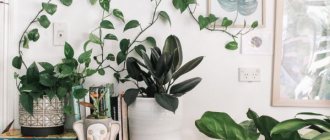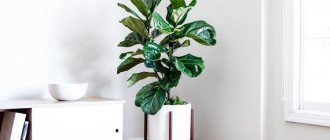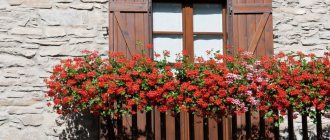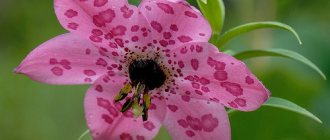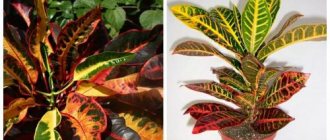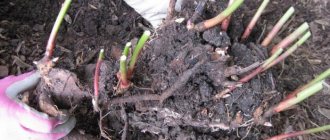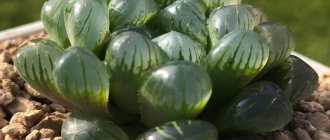Corokia cotoneaster
One of the most interesting house plants. It has tangled dense branches and at the same time an almost transparent crown. The height of the bush is from 30 to 80 cm, it can easily be given any shape.
The small, yellow, star-shaped flowers smell pleasant. Corokia loves bright light, cool temperatures, and moderate watering.
The zigzag growing branches create an unusual tangled lace appearance.
This exotic specimen prefers cool weather, especially during wintering. In summer it needs to be taken out into the fresh air more often.
Cordilina
A beautiful bush with decorative leaves, belonging to the Agave family and to the category of false palms. In general, there are many species of this plant, but some varieties are especially popular, since their plates are colored in certain shades in different intensities:
- Kiwi - intense crimson border;
- Apical - dark red color;
- Red - leaves, like fruits, can be from dark green to bright red;
- Purple compacta - most leaves are green, only a few have a dirty purple tint;
- Rumba - plates with white veins and scarlet edging;
- Tango is a small and neat tree with a lush tuft of leaves of an unusual brown color.
Caring for the plant does not require any special effort, but for the most decorative type of cordyline, you should follow some simple rules:
- diffused light;
- temperature regime - no higher than 22-23°C;
- moderate watering;
- During the growth period, fertilizing is required.
Pteris Cretan
An unusually beautiful species of fern, often grown at home. Despite its sophistication, it is unpretentious in care and is a godsend for beginning gardeners.
Pteris leaves are shaped like feathers. Their colors are very beautiful: a white vein in the middle and green edges. The plant loves diffused lighting; shade and bright sunlight are equally destructive to delicate foliage.
Pteris needs a stable, slightly cool temperature of +20…+22°C. The substrate in the pot is kept sufficiently moist, but water does not stagnate.
Hypoestes
A genus of tropical plants of the Acanthus family. It has amazing foliage color, resembling a face covered with rainbow freckles. Perfect for those who like brightness in the interior. This is a type of branched shrub with unusual leaf blades. The main feature of the plant is the presence on the surface of many dots of different shades: red, white, pink, purple. Well, just like freckles!
The bush is quite unpretentious, it is very easy to care for:
- grows both in small rooms (but with good lighting!) and in the garden with other moisture-loving ornamental plants;
- temperature - from 22 to 25°C, but not less than 17 degrees;
- watering should be plentiful;
- To make the foliage brighter and the shade more clearly visible, use fertilizer with a high potassium content.
Nephrolepis
One of the most popular types of ferns. Huge feathery leaves look impressive both in ampelous compositions and alone. Nephrolepis can be grown as an epiphyte. The pots need to be wide and low, since its root system is small.
The fern with curled, wavy, carved leaves looks original. The culture loves diffused sunlight, fresh air without drafts. In summer, the plant can be taken outside.
Growing nephrolepis is not difficult, but you need to remember that it needs high humidity. To achieve this, it is often sprayed, in hot weather even more than once a day.
Monstera is a miracle
philodendron
It came to our apartments from the humid tropics. There, in the natural conditions of a warm climate with very high humidity, the plant is able to bloom and bear fruit.
Although philodendron is adapted to indoor conditions, flowering , unfortunately, is extremely rare , because the indoor microclimate is completely different from the tropical one. And to recreate climatic conditions close to natural in a living room for a liana is not an easy task, rather an impossible one.
The leaves of this beautiful plant grow up to 30 cm in diameter, sometimes even more. And sometimes the height outgrows the ceiling. It is popularly called “ crybaby ” and “ fortune teller flower ”, because sometimes large drops of moisture appear on the leaves. This phenomenon always occurs before rain, thus she predicts the weather.
Why you can’t keep Monstera at home: signs
There are many different superstitions and signs associated with the monstera. According to some, it brings good luck to the house, others warn that this plant is an energy vampire and call its flower a monster. There is also an opinion that the plant is not compatible with male energy, which means it drives men away from the house. It is possible to debate for a long time about its mystical properties, but it is obvious that it is endowed with extraordinary beauty. And yet, can a monstera flower be kept at home? Let's figure it out.
Myths and reality
monstera in the house
Yes, there are many scandals associated with Monstera. There is evidence that several centuries ago in one of the countries human skeletons were discovered under the roots of a plant. Then the flower began to be considered a killer! But all this is fiction and speculation, and in fact, the vine does not pose any danger to life.
But is monstera poisonous or not?
Of course, there are poisonous plants, for example, Dieffenbachia, but Monstera does not cause harm.
Therefore, it is possible to safely keep a monstera in a house with children and pets. But you should not pick off its leaves, because inside there are microscopic splinters that are released, and irritation of the mucous membranes occurs. Those who experienced it themselves complained of a slight burning sensation.
Monstera benefits and harm
Those who do not believe signs and legends and decide to purchase a beautiful and safe beauty will also receive a number of useful properties:
- helps clean the air from harmful impurities;
- negatively affects viruses and fungi, inhibits their activity;
- saturates the air in the apartment with oxygen and air ions;
- promotes ionization and air humidification;
- With its large, spreading leaves, philodendron not only decorates the surrounding space, but is also able to catch dust.
Monstera flower influence on humans, signs and superstitions
- In Eastern medicine, the plant is used to strengthen the nervous system, stop headaches, develop intelligence, eliminate negative vibrations, and improve the flow of thoughts.
- monstera leaves
The monster is capable of absorbing electromagnetic radiation, which means it must be placed next to household appliances. Monstera is not recommended in a bedroom or nursery, because this large plant absorbs oxygen at night.
- In Asian countries, monstera is considered a talisman that gives the owner good luck and longevity. They place it at the bedside of sick people, near the entrance to the house, believing that the plant does not allow illness and adversity into the home, but attracts wealth.
How could you be sure that the monstera in the house has completely opposite signs? Everyone decides for himself whether to grow it at home and delight the eye with its unusual appearance or be afraid of its notoriety.
The only thing that can cause a refusal to grow monstera is the presence of animals or children in the family. If your pets are too inquisitive, and the kids have not yet gotten rid of the habit of tasting everything, it is worth remembering the presence of microscopic splinters in the foliage of the plant . In this case, it is necessary to put the safety of the household first, and not the decorative properties of the monstera. But, by and large, science considers this plant safe for humans.
Selaginella
A perennial ground cover plant from the genus Mocopod with very original leaves reminiscent of soft coniferous twigs. The shape of the leaves can be needle-shaped, round, spiral.
The colors are also varied: light green, yellowish, dark green and even almost black with a metallic sheen.
Lacy greenery grows very quickly, forming an intricate pattern. She needs diffused light and good moisture. Heat is destructive for club mosses - the plant withers, sheds its leaves and may even die.
Maranta
A tropical flower with an unusual color. The foliage itself is bright green, with clearly visible spots and veins of a red hue. The plant does not require special care. The main thing is to maintain optimal temperature conditions, water in a timely manner, trim dry leaves and replant 2 times a year with the arrival of spring.
An interesting feature of arrowroot is that the upper surface of the leaves is much brighter than the lower surface. This is more than noticeable when the bush lifts its leaves in the evening and folds them slightly.
Davallia
A lush epiphytic fern that seems weightless due to its beautiful filigree greenery. Its thick leaves are pinnately dissected, like those of garden fern species.
It grows very quickly, its roots literally crawl out of the container in which it is planted.
Davallia is unpretentious and loves sunlight. She needs infrequent but abundant watering. You can wash the flower in the shower, avoiding water getting on the soil and roots.
Grevillea is a tree-like competitor of ferns.
One of the fastest-growing indoor plants, grevillea is considered a tree-like analogue of ferns. In their structure, the compound-pinnate leaves are indeed most reminiscent of the luxurious fronds of classical openwork kings, but grevillea is a plant with a different character and with other requirements. Powerful and large, grevillea quickly reveals its true beauty.
Large Grevillea, or powerful Grevillea (Grevillea robusta)
Large Grevillea , or powerful Grevillea (Grevillea robusta) is a tree-like indoor plant, the minimum height of which is limited to 50 cm, and the maximum height can exceed 1-2 meters. The leaf pattern and structure of grevillea is more strict than that of ferns. Double pinnately dissected, the leaves display larger lobes and create patterns reminiscent of conifers.
The lace of grevillea seems somewhat prim, but the plant is still, first of all, memorable for its carved filigree of greenery. The color of the foliage is dark, rich, most often with a silver or bronze tinge, giving the grevillea expressiveness, and the glossy sheen only emphasizes the ornamental crown.
The effect of green lace enhances the tiered arrangement of leaves and the translucency of the crown. In indoor culture, grevillea does not bloom, but in nature, the bizarre inflorescences with protruding stipules and unusual flower shapes themselves look like a lacy miracle.
Grevillea belongs to the Proteaceae family and is an Australian exotic, although it is also found in other countries of Oceania. In nature, it is inimitably tall and graceful: this tree can reach a height of fifty meters without losing the beauty of its feathery leaves. This plant loves acidic, fertile and clay soil.
Grevillea is hardly an easy plant to grow. It requires bright lighting, although it feels best not in a sunny location, but in diffused lighting. Without a cool winter, it is very difficult to succeed in growing this beauty: in winter, optimal conditions for grevillea are limited to 6-15 degrees Celsius.
And during the rest of the year, grevillea feels better in cool rooms with a temperature no higher than 20 degrees. But in summer, a giant grevillea can be placed outdoors, decorating a terrace or balcony with its lacy crown.
Large Grevillea (Grevillea robusta)
Features of grevillea care:
- abundant watering, maintaining stable average soil moisture, preventing drought or dampness;
- for grevillea use only soft water;
- the plant needs frequent ventilation;
- requires frequent and abundant feeding from March to October.
Grevillea is a solitary plant. It is used as an unusual openwork wood and is usually placed on the floor. This beauty will need a lot of space: if not formed, grevillea can reach several meters in height. But even ferns will not create such a filigree, lacy background and “forest atmosphere”. This is an ideal wood for framing a relaxation area, decorating spacious rooms with a boring design. Grevillea looks great on staircases and entryways.
Maidenhair
One of the most beautiful openwork indoor plants. Its graceful shoots add freshness to the room. Adiantum is demanding on lighting, watering and temperature. It needs to be sprayed daily with a spray bottle and ensure that the substrate in the pot is moist.
The plant does not tolerate heat and thrives in partial shade. The fern does not tolerate drafts and tobacco smoke. Adiantum is periodically pruned, removing old dried branches.
Plant pests
- Mealybug. Signs of damage: young foliage and shoots of the plant. To combat the pest, the affected areas are treated by wiping with a soap solution, then sprayed with a 0.15% Actellik solution.
- Shield. Signs: the plant becomes covered with small brown plaques, which leads to the leaves drying out and completely falling off. They destroy scale insects in the same way as mealy mites.
- Spider mite. It entangles the foliage of the plant with a thin web, which leads to its lethargy and lifelessness. In this case, treating the leaves with soapy water and specialized store-bought products can help. Red spider mite infestations appear as many dark spots on the underside (hidden) side of the leaf blade.
- Thrips. Signs: the outer side of the leaves is densely covered with light dots, while the pests themselves are located on the inside. Spraying with a solution of a suitable insecticide helps get rid of insects.
Growing errors: Monstera leaf diseases
What are the signs of improper monstera care?
- Has the plant stopped producing new leaves for a long time? The existing support should be replaced with a higher and stronger one.
- Is the plant's young foliage small, pale, and unslitted? This means that the monstera suffers from a lack of light.
- Is the foliage turning brown and drying out? The plant suffers from low indoor humidity and high temperature.
- Drops of moisture appear on the leaves, then they wither? This happens due to excessive watering and excess humidity. If measures are not taken, the shoots will also wither and begin to rot.
What conclusions can be drawn? If you follow all the available recommendations and take proper care of your monstera at home, everything will be just fine.
trap leaves
Perhaps the most “highly specialized” are trapping leaves. They are present on carnivorous plants that feed on insects. A striking example is the sundew or Venus flytrap. The main task of such a leaf is to catch an insect, ensure its retention, and digest it with the help of special enzymes. The method of capture is different: in some cases the leaf produces sticky juice (sundew), in others it closes abruptly (Venus flytrap), in others special bubbles with valves come into action (pemphigus).
Classification by type of leaf blades
This classification is based on the number and division of leaves growing on one cutting or from one node of the stem (trunk). According to this, the simplest type is a simple leaf. It is characterized by the presence of only one leaf blade and one petiole. The leaf surface itself is called a plate, that is, its “canvas” with veins. In a simple leaf it can have any shape, but the cuts never reach the petiole. Leaves of the simple type always fall off along with the petiole, leaving not a single part of it on the tree.
The next type is a compound leaf. Here, several leaves are attached to one petiole at once. Moreover, each of them can have its own additional petiole.
